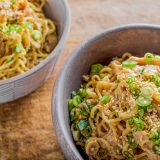
By boiling Italian pasta in water alkalized with baking soda, it’s possible to mimic the firm, chewy texture of ramen noodles. In a large pot, bring 2 quarts water to a boil. Add 4 teaspoons baking soda and 10 ounces thin spaghetti. Cook, stirring occasionally, until tender. Drain the noodles in a colander, then rinse under cold running water, tossing well, until fully cooled, then drain again.
Cold pasta salads may be a summer staple, but too often they also are a seasonal letdown. Rotini or farfalle invariably dissolve into bland, clammy mush as the starchy pasta sucks up moisture from the dressing. Turns out, we’re simply using the wrong noodles.
Across Asia, noodle salads are light, refreshing and never mushy. Take hiyashi chuka, a cold ramen dish that’s a summertime staple in Japan. Unlike Italian pasta, the noodles stay chewy and bouncy because they’re made with kansui, a blend of alkaline salts. In addition to adding an eggy flavor and yellow hue, kansui fortifies and strengthens the gluten in the noodles. This stronger gluten network wraps around the starches in the noodles, forming a water-resistant barrier that allows ramen to hold up just as well to cold dressings as it does in hot soups.
“The alkali gives ramen that spring and slurp that you just don’t get from regular pasta,” says ramen authority Ivan Orkin, who serves hiyashi chuka at his New York City restaurant Ivan Ramen.
Setting out to create a refreshing cold noodle dish of our own, we knew we needed to start with the right noodle. We took Orkin’s lead and opted for ramen. Instant ramen had the wrong texture, but non-instant dried ramen, sometimes known as chuka soba, was perfect and can be found in well-stocked grocery stores.
We also found you can convert Italian pasta into ramen. Adding baking soda to boiling water creates an alkaline solution that transforms spaghetti into firm, chewy, ramen-like noodles. True ramen was better, but the “ramenized” pasta was a close second choice.
With our noodles sorted, we focused on the dressing and took inspiration from the sweet-savory-vinegary profile of those used in many Asian salads. We tossed toasted sesame seeds, sesame oil, soy sauce, vin- egar, mirin and ginger into the blender, then poured it over boiled noodles. Not only was the result wonderfully flavorful, the noodles never turned mushy.
Related Recipes
July-August 2020

Sign up to receive texts
Successfully signed up to receive texts!
We'll only send our very best offers - Like a $15 store credit to start.
By entering your phone number and submitting this form, you consent to receive marketing text messages (such as promotion codes and cart reminders) from Christopher Kimball's Milk Street at the number provided, including messages sent by autodialer. Consent is not a condition of any purchase. Message and data rates may apply. Message frequency varies. You can unsubscribe at any time by replying STOP or clicking the unsubscribe link (where available) in one of our messages. View our Privacy Policy and Terms of Service.



